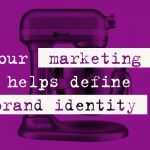Pont Bleu is a Branding and Communication agency. Now, given that we are communication experts you wouldn’t expect us to sell ourselves with a term that is not commonly understood. Yet it is surprising how often we hear “What is Branding ?”
If given the chance to explain, many will conclude too quickly that we are graphic designers. And while not wrong (because we are), the term ‘branding’ goes a whole lot further.
BusinessDictionary.com explains branding as:
The process involved in creating a unique name and image for a product in the consumers’ mind, mainly through advertising campaigns with a consistent theme. Branding aims to establish a significant and differentiated presence in the market that attracts and retains loyal customers.
That is the aim, and it manifests itself perfectly in a quote from Amazon’s Jeff Bezos: “Your brand is what people say about you when you’re not in the room”.
When you dive into the wonderful world of branding, You will often hear terms like brand identity, brand image, brand essence and brand positioning used interchangeably, however, if you just understand what constitutes a brand then you will be able to invent your own marketing buzz term!
What constitutes a brand?
A brand is not just a logo design. You can’t just design a logo and say “that’s our brand.”
Your logo design is only one tiny part of the branding puzzle.
Branding is how people view and perceive your company. It’s also how you as the owner, and your workforce view and perceive the company.
It’s about how an audience connects with your company on multiple levels, and through every brand touchpoints. Given that a brand is the character of the company and that character is built by just about every aspect of business, an easier question would be: what doesn’t affect a brand?
What is sure is that a designer can’t ‘create’ a brand, but they do establish an identity that reflects a brand. The brand has to come from the company, it corresponds with:
- Their core values
- Their USP (unique selling point)
- Their target customers (linked to the company’s positioning)
Questions like this form the basis of a brand. A designer or design agency then builds on this foundation by creating or enhancing the brand’s visual identity.
Your logo is the embodiment of the brand concept wrapped up into one easily identifiable image, but always remember, a logo design alone is not a brand. It only represents a brand.
A brand agency weaves together the brand values with the visual identity, taking concepts and ideas from the company’s brand strategy and assembling them in the most appropriate format while improving or refining the original strategy along the way.
How can I improve my brand’s character?
Before you rush off to a designer or branding consultancy, there are some simple and low-cost ways of making a difference to your brand strategy that you can start today to help build or reinforce your brand.
Here are five questions to get you thinking about improving your brand.
- What does your brand stand for?
Ask yourself what your brand is all about. What does your brand believe in? What do you want people to think about your brand when they hear your brand name? What is the character of your brand?
“Make a list of the differences and the extremes and start with that. A brand that stands for what all brands stand for, stands for nothing much.” – Seth Godin
- What visual brand collateral do you already have?
Spread your branded material out and take a good look at it. Do you have a logo? Are you using a consistent identity across all of your printed material? Does your logo represent the character of your company today? Are you presenting a harmonious approach across all of your media?
- Are you using social media correctly?
Among your carefully crafted list of brand touchpoints, you need to have your share of online contact. Is your brand represented on social networking sites?
It’s best to keep your social media sites consistent in style to your printed collateral and your website design.
You also need to think about the tone and style of language you use, what you talk about and what subjects you share on social media. Like no other media, social networks can exponentially spread the word about your brand, but beware; bad news can be halfway around the globe when good news is still pulling its boots on!
- Is your website yielding results?
If your website doesn’t look similar to the rest of your branded materials, then it’s time to bring it in line. Think about the way you present your service or product online. Are users seeing it in a positive light?
Does your website produce the results you were hoping for? Are you making enough sales through your site? If you’re not, it’s worth exploring the user experience of your site.
Ask friends and family for feedback.
Is it easy enough for your users to make a purchase, or get in contact? Does your site work as it should? There are lots of questions you can ask yourself, but even if you fix only the most basic of problems you will be ahead of the game.
- What can you do to change it?
You could go about realising your brand strategy yourself, although the main aim is to improve how others perceive your organisation, service or product. It could be that you’re too close to the situation to be fully objective, or possibly you could be so used to the way things are that areas of improvement go straight past you.
If you’re unsure about any of the things we’ve talked about above, then I’d advise getting in touch with a professional branding or design agency to see how they can help you. A lot of agencies (including Pont Bleu) offer a design consultation before starting work on a project.

Branding Consultant at Pont Bleu Communication
Daren Birchall’s career spans more than 30 years. He is a graphic designer, writer, analyst and communications strategist, marketing consultant, media buyer, production manager, and for quite some time was an advertising agent. He loves photography but his glasses bother him.


